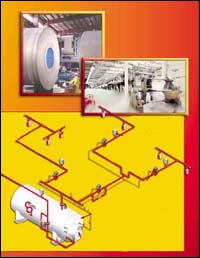Potential Hazards:
- Accidental discharge of fire extinguisher.
- Miscommunication and coordination with:
- Ship owner and prime contractor
- Prime contractor and subcontractor
Requirements and Example Solutions:
- When active fixed extinguishing systems
could create a dangerous atmosphere in vessels and
vessel sections: [1915.506(a)]
- Physically isolate the system or use other positive means to prevent the
systems' discharge. [1915.506(b)(1)]
- Ensure that employees are trained to recognize: [1915.506(b)(2)]
- Systems' discharge, evacuation alarms and appropriate escape routes. [1915.506(b)(2)(i)]
- Hazards associated with the extinguishing systems and agents including the
dangers of disturbing system components and equipment (such as piping,
cables, linkages, detection devices, activation devices, and alarm devices).
[1915.506(b)(2)(ii)]
- During sea and dock trials, all systems must remain operational.
Ensure that: [1915.506(c)]
- All doors, hatches, scuttles, and other exit openings remain working
and accessible for escape in the event that the systems are activated. [1915.506(d)(1)]
- All inward opening doors, hatches, scuttles, and other potential
barriers to safe exit are removed, locked open, braced, or otherwise secured.
[1915.506(d)(2)]
- When testing a fixed extinguishing system, all workers must be
evacuated from the space during discharge. Oxygen level must be tested to ensure
safe conditions prior to workers reentering the space. [1915.506(e)]
- Fixed extinguishing system must be physically isolated before conducting maintenance on
the system. [1915.506(f)]
- When fixed
manual extinguishing systems are used to provide fire protection for spaces
in which work must be performed, ensure that: [1915.506(g)]
- Only authorized workers are allowed to activate the system. [1915.506(g)(1)]
- Authorized workers are trained to operate and activate the systems. [1915.506(g)(2)]
- All workers are evacuated from the protected spaces, and accounted for,
before the fixed manual extinguishing system is activated. [1915.506(g)(3)]
|

Figure 2. Schematic of high pressure CO2 fire
extinguishing system used on vessel.

Figure 3. Schematic of low pressure CO2 fire
extinguishing systems used on vessel.
|

